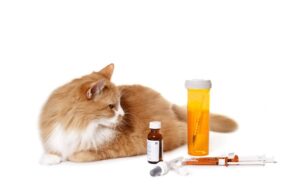-
Adopt
-
Veterinary Care
Services
Client Information
- What to Expect – Angell Boston
- Client Rights and Responsibilities
- Payments / Financial Assistance
- Pharmacy
- Client Policies
- Our Doctors
- Grief Support / Counseling
- Directions and Parking
- Helpful “How-to” Pet Care
Online Payments
Emergency: Boston
Emergency: Waltham
Poison Control Hotline
-
Programs & Resources
- Careers
-
Donate Now
 By Catherine Sumner, DVM, DACVECC
By Catherine Sumner, DVM, DACVECC
angell.org/emergency
emergency@angell.org
781-902-8400
MSPCA-Angell West, Waltham
When patients are critically ill, they often require polypharmacy, the concurrent use of numerous medications in the patient. These patients may have been receiving pre-existing medications in addition to new medications. In addition, during hospitalization, these patients are typically also receiving intravenous fluids and may also have supplemental nutrition and blood products administered. As our patients are given increasing numbers of medications, the risk for potential drug interactions rises. It is important to obtain a thorough history including any recent or current medications and supplements. As additional medications are added, the list of current medications and medical problem list should be checked to identify any potential interactions or issues.
Drug interactions can be divided into main categories of: changes in drug absorption, pharmacodynamic interactions, pharmacokinetic interactions, physical incompatibility, and protein binding.
The first consideration when evaluating drug absorption is which route of administration to use. When medications are administered orally to critically ill patients, drug absorption is often decreased. Reasons can include decreases in blood flow to the gastrointestinal tract, abnormal gastrointestinal transit time, as well as gastrointestinal clinical signs, but the degree to which drug absorption is affected is difficult to determine. Thus, if a parenteral option is available for a medication, this is often preferable. However, oral formulations may be the only option for certain medications. For medications being given by mouth, it is important to evaluate for compatibility with other oral medications and the patient’s diet. For example, sucralfate, a commonly prescribed gastrointestinal mucosal protectant, should be administered on an empty stomach and separated from other oral medications by 2 hours because it could decrease absorption of other PO medications. Other considerations that can affect oral medication absorption from the stomach include whether the medication is lipophilic, the pH of the stomach, and when the patient last ate.
Pharmacodynamics refers to the mechanism of action of drugs, or how the drug affects the patient. When looking at pharmacodynamic interactions, we are referring to when the mechanism of action of one drug affects the absorption or action of another medication. A classic example of a compounding result of multiple medications is serotonin syndrome, where an animal receives multiple medications that increase serotonin levels (these medications can act in various ways – decreasing reuptake, increasing production, increasing release, inhibiting metabolism, or stimulating receptors). A way this could happen in our patients is concurrent administration of mirtazapine (a tetracyclic antidepressant) and tramadol (which interferes with serotonin reuptake). The use of intravenous lipid emulsion (ILE) therapy (usually administered to treat toxicity) can also affect other medications the patient is receiving, particularly those that are lipophilic. Thus, a patient receiving ILE for another reason could develop decreased levels of diazepam, local anesthetics, calcium channel blockers, ivermectin, carprofen, and other medications.
 Pharmacokinetics involves drug absorption, distribution, metabolism, and excretion from the patient; basically, what the patient’s body does with the medication. Drugs are metabolized in various parts of the body: blood, gastrointestinal tract, kidneys, liver, and lung. It is important to consider the function of the organ responsible for metabolism and excretion of a medication, as alterations in organ function could affect the medications being administered. Dysfunction could result in drugs not being metabolized and excreted in the expected time frame, requiring changes to be made in medication dosing. For example, patients with acute kidney injury often receive decreased doses or decreased frequency of administration of medications that are excreted renally. The liver is responsible for much of the metabolism of medications administered.
Pharmacokinetics involves drug absorption, distribution, metabolism, and excretion from the patient; basically, what the patient’s body does with the medication. Drugs are metabolized in various parts of the body: blood, gastrointestinal tract, kidneys, liver, and lung. It is important to consider the function of the organ responsible for metabolism and excretion of a medication, as alterations in organ function could affect the medications being administered. Dysfunction could result in drugs not being metabolized and excreted in the expected time frame, requiring changes to be made in medication dosing. For example, patients with acute kidney injury often receive decreased doses or decreased frequency of administration of medications that are excreted renally. The liver is responsible for much of the metabolism of medications administered.
One of the most important considerations when looking at pharmacokinetic interactions is the cytochrome P450 system, which is found in the liver. The cytochrome P450 system processes many drugs before they are excreted from the body. Importantly, medications can have effects on the P450 system, by inhibiting it (which results in increased levels of drugs that are typically metabolized by the P450 system) or increasing activity (which results in decreased levels of drugs that are typically metabolized by the P450 system due to increased clearance of these drugs). Common medications that inhibit P450 include cimetidine, ketoconazole, metronidazole, omeprazole, and trimethoprim-sulfa. A common medication that increases P450 activity is phenobarbital. Sepsis can also affect the P450 system.
Another important consideration is physical incompatibility of medications. It is important to ensure that medications are compatible with whatever IV fluids are being administered as well as with other medications being administered through the same injection port. Incompatibility can lead to precipitation of particles which are then injected into the patient. Prior to administration, syringes should be evaluated visually for precipitate. While resources are available to check for compatibility between various medications and between medications and fluids, it is always best to avoid potential contact between medications. In our critical patients, multiple intravenous catheters are often placed, or a central line with multiple separate ports may be present. Either of these situations allows for administration of medications separately. If a medication can be administered subcutaneously or intramuscularly and have a similar effectiveness, this could be considered instead of an intravenous injection to avoid unwanted interactions.
A final consideration is protein binding of drugs. When in the body, drugs can be bound to plasma protein (primarily albumin) or unbound. When a drug is bound, it is inactive; when it is unbound, it is pharmacologically active. When protein levels decrease, more drug is left unbound and thus more is available in the active form. Or, when multiple drugs that bind to protein are administered concomitantly, they can bind to protein at different rates, resulting in increased active levels of certain medications. The medication that is unbound at a higher rate may also be cleared from the body more rapidly.
The number of factors that must be considered when selecting and administering medications can appear daunting. However, with a systematic approach of evaluating the patient’s current medical problems and medications, appropriate choices can be made that will treat the patient appropriately and avoid polypharmacy related complications.